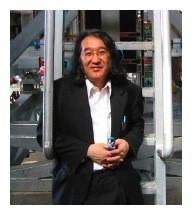The U.S. National Science Foundation (NSF) recently announced a $2 million award for an international consortium aimed at probing novel superconductors with neutrons, muons, and photons through its Partnership in International Science and Engineering (PIRE) initiative. TRIUMF will play a unique and critical role in network through its muon-spin resonance program at the Centre for Molecular and Materials Science (CMMS). The principal investigator is Dr. Yasutomo Uemura, a professor of physics at Columbia University, a core contributor to the CMMS, and a regular visitor to TRIUMF. The project began August 1, 2010, with funding for three years.
International partnerships are, and will be, increasingly indispensable in addressing many critical science and engineering problems. Recognizing that progress in key research problems requires global cooperation, NSF’s PIRE program supports targeted collaborations that combine capabilities, talents, and resources for a world-wide effort to attack high-priority science questions. The program is designed to, “Support bold, forward-looking research whose successful outcome results from all partners—U.S. and foreign—providing unique contributions to the research endeavor.” In this case, the consortium will focus on exploring novel superconductors using the combined power of muon, neutron, and photon probes along with scanning-tunnelling microscopy.
 |
|
“Participating in and contributing to this focused research program is a privilege and an honour,” said Nigel S. Lockyer, TRIUMF’s director. “We’ve got unique capabilities here at TRIUMF that can shed a special light on some aspects of this science. And we will have the benefit of sharing in results generated elsewhere around the world as well as having some of the world’s best and brightest come to TRIUMF to study how and why these superconductors behave so differently from conventional theory. This is exactly what we mean when we say that TRIUMF acts as a gateway for Canada to global science and technology!”
Since the 1980s, various new superconductors have been discovered: heavy-fermion, CuO, alkali-doped A3C60, organic BEDT, and the most recent FeAs systems. Interestingly, these novel superconductors exhibit many commonalities. Several experimental results, such as the superfluid density studied using mSR by Professors Uemura and Graeme Luke (McMaster) at TRIUMF indicated that these “correlated-electron” superconductors are fundamentally different from conventional superconductors (like Al or Sn) explained by traditional BCS theory. Despite unprecedented accumulation of experimental and theoretical studies, however, basic mechanisms of superconductivity in high-Tc cuprate and other novel superconductors have not yet been clarified.
In addition to being an attractive intellectual challenge, the quest for mechanisms of novel superconductors is extremely important for the further development of systems with higher transition temperatures suitable for application to electronic devices and power transmitting wires. Towards the goal of solving this mystery, this consortium will investigate FeAs, CuO and heavy-fermion superconductors (CeCoIn5 and URu2Si2) in a coherent effort by using powerful experimental probes, i.e., neutrons, muons, photons and STM. Although energy scales of heavy-fermion systems are much lower than those of CuO and FeAs systems, better understandings of commonalities of these systems would help development of a generic picture for novel and unconventional superconductors.
Since the beginning of the 1980s, in parallel with the progress of researches of unconventional superconductors, experimental methods for condensed matter physics using particle accelerators have made spectacular progress, thanks to development of high intensity sources and state-of-the-art spectrometers with superb resolutions. Such progress include: [neutrons] detailed mapping of inelastic responses by neutron scattering using time-of-flight spectrometers at ISIS (UK); [muons] elucidating magnetic order and super-fluid densities by muon spin relaxation at TRIUMF (Canada) and PSI (Switzerland); and [photons] high-resolution X-ray scattering and Angle Resolved Photoemission Spectroscopy (ARPES) using synchrotron light sources all over the world. In addition to these particle probes, Scanning Tunneling Microscopy (STM) is a new, unique, and extremely powerful table-top method of solid state physics invented in the 1990s.
While these new probes have made many decisive contributions to recent progress of understanding novel superconductors, traditional photon probes, infrared optical conductivity and Raman spectroscopy, have also made seminal contributions in studies of cuprates, including detection of pseudo-gap (infrared) led by PI Uchida and LE Timusk and distinction between nodal and antinodal responses. The present PIRE project aims to gather international leaders of experimentalists using these probes to make further progress with coherent focal themes.
The proposal outlines three chief advantages of the global consortium:
- Combined capabilities of specialized facilities;
- High-quality specimens from Japan, Canada, and China; and
- Face-to-face collaboration of theorists, phenomenologists, and experimenters on key topics.
The international collaboration is absolutely essential to the proposal, and brings together the individual components for progress to be made in the field of high Tc supercondcutors. The topic of research is at the frontier of knowledge, and has received renewed worldwide attention since the recent discovery in Japan and China of superconductivity in a family of new materials based on layered FeAs-lanthanides. By joining the resources and expertise available in the partner countries there will be possibility of gathering relevant experimental information to understand the fundamental mechanisms of superconductivity in these new type of materials.
Two undergraduate fellows through PIRE are working at TRIUMF and have started a blog to share their experience. Enjoy their humourous and physics-laden adventures!
-- By T.I. Meyer, TRIUMF's Head of Strategic Planning and Communications, with special thanks to Yasutomo Uemura.

